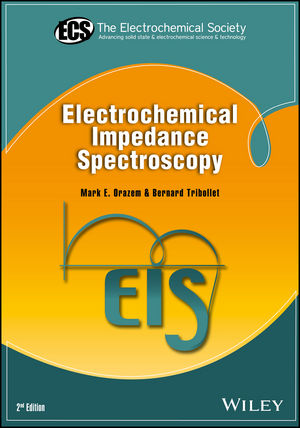 Electrochemical Impedance Spectroscopy (2nd Edition), by Mark E. Orazem and Bernard Tribollet, provides the fundamentals needed to apply impedance spectroscopy to a broad range of applications with emphasis on obtaining physically meaningful insights from measurements. The second edition provides expanded treatment of the influence of mass transport, time-constant dispersion, kinetics, and constant-phase elements.
Electrochemical Impedance Spectroscopy (2nd Edition), by Mark E. Orazem and Bernard Tribollet, provides the fundamentals needed to apply impedance spectroscopy to a broad range of applications with emphasis on obtaining physically meaningful insights from measurements. The second edition provides expanded treatment of the influence of mass transport, time-constant dispersion, kinetics, and constant-phase elements.
The new edition improves on the clarity of some of the chapters, more than doubling the number of examples. It has more in-depth treatment of background material needed to understand impedance spectroscopy, including electrochemistry, complex variables, and differential equations. This title includes expanded treatment of the influence of mass transport and kinetics, and reflects recent advances in the understanding of frequency dispersion and interpretation of constant-phase elements.
This monograph is sponsored by ECS, and published by John Wiley & Sons, Inc.
About the Authors
Mark E. Orazem is a Professor of Chemical Engineering at the University of Florida. He organized the 6th International Symposium on Electrochemical Impedence Spectroscopy and teaches a short course on impedance spectroscopy for The Electrochemical Society.
Bernard Tribollet is the Director of Research at the Centre National de la Recherche Scientifique and Associate Director of the Laboratoire Interfaces et Systémes Electrochemique at Pierre and Marie Curie University. Dr. Tribollet instructs an annual short course on impedance spectroscopy.
Visit the ECS Online Store to purchase your copy today!
 As we are getting ready to go to the 231st ECS Meeting in New Orleans, we thought of some things we didn’t want you to forget!
As we are getting ready to go to the 231st ECS Meeting in New Orleans, we thought of some things we didn’t want you to forget!

 Electrochemical Impedance Spectroscopy (2nd Edition), by Mark E. Orazem and Bernard Tribollet, provides the fundamentals needed to apply impedance spectroscopy to a broad range of applications with emphasis on obtaining physically meaningful insights from measurements. The second edition provides expanded treatment of the influence of mass transport, time-constant dispersion, kinetics, and constant-phase elements.
Electrochemical Impedance Spectroscopy (2nd Edition), by Mark E. Orazem and Bernard Tribollet, provides the fundamentals needed to apply impedance spectroscopy to a broad range of applications with emphasis on obtaining physically meaningful insights from measurements. The second edition provides expanded treatment of the influence of mass transport, time-constant dispersion, kinetics, and constant-phase elements. The U.S. Department of Energy spends
The U.S. Department of Energy spends 

 Ten new issues of ECS Transactions (ECST) have just been published for the upcoming 231st ECS Meeting. The papers in these issues of ECST will be presented in New Orleans, Louisiana, May 28 – June 1, 2017.
Ten new issues of ECS Transactions (ECST) have just been published for the upcoming 231st ECS Meeting. The papers in these issues of ECST will be presented in New Orleans, Louisiana, May 28 – June 1, 2017. Over one million scientists and science advocates around the world took to the streets on April 22 to celebrate science and bring attention to the role it plays in improving lives, solving problems, and informing evidence-based policy.
Over one million scientists and science advocates around the world took to the streets on April 22 to celebrate science and bring attention to the role it plays in improving lives, solving problems, and informing evidence-based policy. There are only 10 days left to submit your abstract to the
There are only 10 days left to submit your abstract to the  The
The  U.S. Secretary of Energy Rick Perry in April
U.S. Secretary of Energy Rick Perry in April